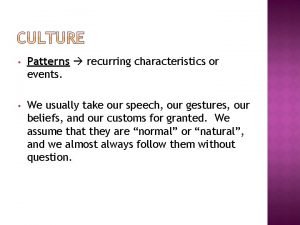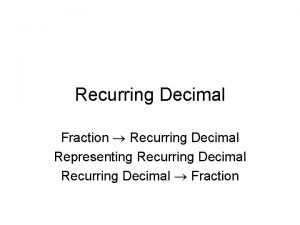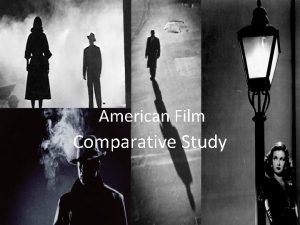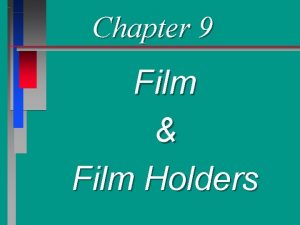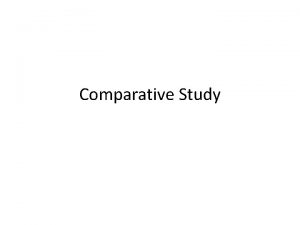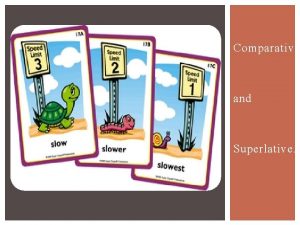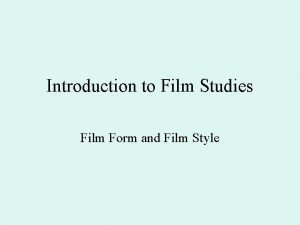American Film Comparative Study Recurring issues Messages and











- Slides: 11

American Film –Comparative Study

Recurring issues • Messages and values – ideology/morality • Representation • Style/genre characteristics • Context

How far do the American films you have studied for this topic express similar messages and values to one another?

What will the examiner will be looking for, whatever the question?

• Context: post depression era, wartime, Hays code, etc vs. the post-feminist era • Genre characteristics: cynical atmosphere, crime story, sex as a motive, character archetypes, male perspective vs. objective narrative, the inevitability of fate, flashback structure, narrative tropes what equilibrium is reached, etc. • Style: Chiaroscuro lighting, hard-boiled dialogue, iconography, character archetype, etc. • Representation: gender, sexuality, ethnicity

Definitely include: • Examples – know key scenes from both films You will NOT be asked to refer to specific sequences but you may be directed to compare openings or endings • Reference to cinematic style • Genre characteristics • Context (whether asked for this directly or not)

Messages and Values Gender representation in classic noir • The female who destroys the family unit is unnatural to be punished • Masculinity is challenged and seeks a way to reassert itself • Male relationships are stronger than sexual lust • Male authority restored at the end • The male viewpoint is presented as natural, if burdened with doubt The rule of ‘natural law’ in classic noir (thanks, Hays code!) • • • The good are rewarded Order is restored The guilty are punished Confession cleans the soul Fate is inevitable • Consider how The Last Seduction defies all of these and why

“In Double Indemnity, Phyllis is introduced using a male gaze shot” Wilder follows genre convention by introducing his femme fatale with the typical ‘male gaze’ shot. Neff’s reaction confirms that this is shot-reverse shot and his perspective. She is seen from below, only partly covered. As she descends the stairs, we linger over her ankles. We are asked to look at her in the same way Neff does – as a sex object. This underlines the masculine viewpoint of these films. The shot is typical of film noir. It is also used in Tay Garnett’s The Postman Always Rings Twice, for example. The shot shows that classic noir ideology is male dominated and assumes a male perspective. The narrative is also constructed around the male protagonist’s confession, which privileges his point of view.

“In The Last Seduction, there are no male gaze shots. ” In contrast, Dahl’s camera often lingers over Bridget’s body, particularly her legs. The tops of her stockings are often on display from a low angle, such as when she exits the taxi after her visit to Trish. This clearly sexualises her for the spectator and emphasises her attraction, despite the unfeminine aggressiveness of her performance. However, none of these sexualising shots are from Mike’s point of view and the male gaze is notably not used in their initial meeting in the bar when Mike first sees her. This has the effect of distancing Mike from our perspective and is a subtle difference between the classic neo-noir.

Read the Band 4 example: How far do the American films you have studied for this topic express similar messages and values to one another? Identify what went well: • Context • Genre • Style • Representation

Compare how far the openings of the American films you have studied for this topic establish their messages and values
 Explain wedge film and squeeze film journal bearings
Explain wedge film and squeeze film journal bearings It looks for patterns recurring characteristic and events
It looks for patterns recurring characteristic and events Issues in information systems
Issues in information systems Recurring decimals to fractions gcse exam questions
Recurring decimals to fractions gcse exam questions The recurring aspects of designs are called design
The recurring aspects of designs are called design Beats organized into recognizable accent patterns
Beats organized into recognizable accent patterns Recurring decimals
Recurring decimals The recurring aspects of designs are called design
The recurring aspects of designs are called design The recurring aspects of designs are called design
The recurring aspects of designs are called design 26373737
26373737 Recurring pattern meaning
Recurring pattern meaning A recurring pattern that is present in all mishaps.
A recurring pattern that is present in all mishaps.

